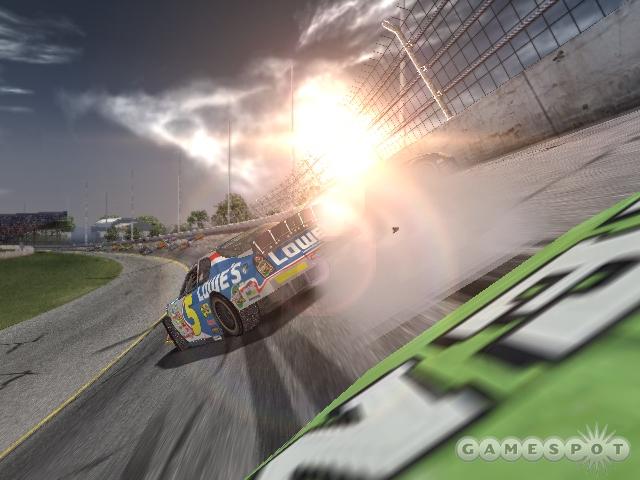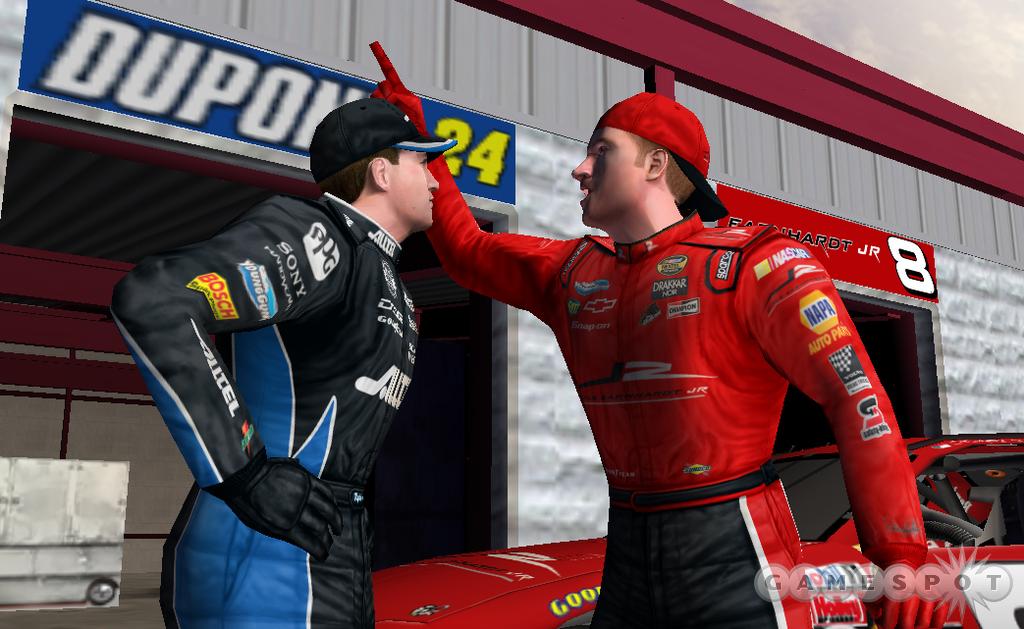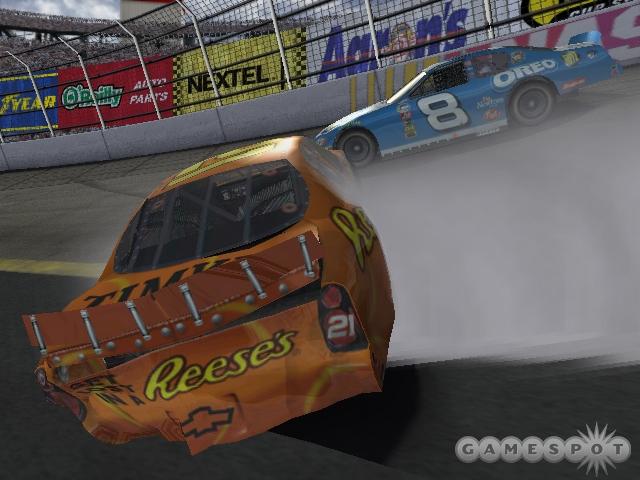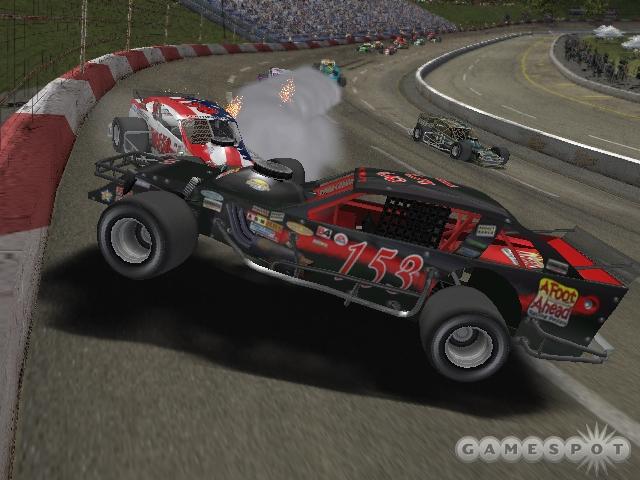NASCAR 2005: Chase for the Cup Designer Diary #1
Assistant producers/codesigners Mike DeVault, Matt Lewis, and Sean Wilson take us through the process of creating one of the modes in EA's latest entry in its NASCAR franchise.
With NASCAR Thunder, Electronic Arts has long provided NASCAR fans with games that simulate their favorite sport. This year, the series has undergone a name change--now it's called NASCAR 2005: Chase for the Cup--and it's getting a substantial gameplay overhaul as well. In our first designer diary, designers Mike DeVault, Matt Lewis, and Sean Wilson will fill us in on one of the new modes you'll find in this new NASCAR game.
The Evolution of Fight to the Top Mode
By Mike DeVault, Matt Lewis, and Sean WilsonAssistant producers/codesigners, EA Tiburon

The design process on the NASCAR 2005: Chase for the Cup project was a collaborative effort involving a small group of highly motivated and dedicated people here at the Tiburon Studios in Orlando. Once the design was put in place, our development and art teams worked tirelessly to pull it all together. We're all avid NASCAR fans and our main goal was to create a game mode that would reflect our passion for racing as well as introduce new fans to the game and the sport.
In this diary we're going to discuss the creation and design process surrounding our latest and greatest feature, "Fight to the Top" mode. Fight to the Top came from the desire to create a mode that genuinely reflects the real-life climb drivers make to get to the NEXTEL Cup series. The end result was a feature that allows players to start a racing career as an aspiring driver with hopes of making it big in the world of NASCAR. The fight to the sport's premier series won't be without a challenge, however, as players will have to rise through the ranks of three other racing circuits before landing in the big time. Proving yourself worthy to be NASCAR's next big thing won't be easy though. Besides finishing well in your races, you'll have to manage your driver's prestige, fan support, as well as your on-track reputation. Once you've put all the pieces in place, you'll start carving your niche in the sport on the way to superstardom.
In previous years, our game experience was limited to merely driving in NEXTEL Cup series races. One of our first problems was that we needed to expand upon the depth of racing in the game. So to that end, we knew that NASCAR was more than just stock car racing. There were several more racing series sanctioned by NASCAR that we hadn't yet tapped into. So we came up with the idea of adding other NASCAR racing series to our existing career mode. We settled on the addition of 3 new series, NASCAR Featherlite Modifieds, NASCAR Craftsman Trucks, and NASCAR Busch series cars.
As we started to brainstorm ideas on how to implement these new cars to the game, we came to the conclusion that these additional racing series wouldn't fit into the existing scope of our current career mode. So we decided to start from scratch on a similar feature that would be more engaging and dynamic. This was when Fight to the Top was first conceived.
Over the years, we have spent a great deal of time talking to drivers, such as: Elliott Sadler, Ryan Newman, Bobby Labonte, and others. Often we would just talk to them about how they became involved in racing. Each driver usually started off in some small series in some small town and they literally had to fight for their spot in the Nextel series. This feedback we got from the drivers helped us to build a foundation for a story that would eventually become Fight to the Top mode.

We now had a goal for this new mode, to take a player of limited means and stature through four racing series into the NEXTEL Cup series with the main goal of winning the NEXTEL Cup. Our next challenge was now to develop a plan on how to bring it all together. We decided to flush out all the other elements that a game mode like Fight to the Top needed to make it feel realistic. These were the day-to-day experiences that a driver faces every day in a racing career that we wanted to incorporate into the game. So we began brainstorming and creating designs for things such as fan support, autograph signing, driver prestige, merchandising, hero/villain status, and relationships with other drivers. All of these features were important in telling the story of a driver fighting his way to the top, but the ultimate challenge was to find a way to make them all work cohesively throughout four different racing series.
Our next goal was to create a progression through Fight to the Top that would give the player choices. We wanted the player to have more options on where, when, and what he could race and what he had to manage. This was important to us because not everybody likes to do the same things when playing a game, so we decided to create a more customizable experience for Fight to the Top. Through the game's progression, we wanted to control how a player jumped to a new series and how fast these jumps would occur. We didn't want him to languish in one series for too long, but at the same time we didn't want him to shoot straight to the NEXTEL Cup series too quickly. That's when we decided to add a role-playing game element to Fight to the Top mode. We created a driver prestige rating system that controlled how quickly the driver would move through the ranks. Prestige would be the main attribute of the player's driver and it would be earned by finishing well in race events. This put the player in charge of how fast his driver would progress through Fight to the Top.
When the player chose to drive under contract, his prestige level would trigger test sessions. Real-life racing teams often put drivers in their cars to "test" their ability before offering them a contract. We knew test sessions would be a great way of determining whether a player's skill had progressed to the point where he was ready to jump to a higher series. We jumped at the chance to incorporate this, as it added another touch of realism and at the same time functioned extremely well within the framework of our game mode.

The owner mode option was easier for us to lay out. The player, after earning enough money, could always purchase his own racing team in any series and not worry about having to participate in test sessions. But the variety was nice. The player now has the choice of becoming an owner or racing under contract. The beauty here is if the player just wants to drive, he can do that. If he wants to manage all the aspects of a team, he can do that too. It's completely up to the player.
To increase the total number of different racing experiences in Fight to the Top, we created two other racing experiences for the player: showdown races and charity events. Showdowns offered us the chance to give the player a more personal connection with the drivers of NASCAR. These one- on-one production car races against the stars of the NEXTEL Cup series would also offer a different experience not normally found in this kind of game. The production cars we used actually play a major role in the sport. NASCAR drivers are involved quite frequently in the testing of these vehicles for their car manufacturers. Charity races would be limited field races that the player could compete in if invited. Invitation would be determined by track performance and, more importantly, by how big of a fan following the player had earned. We just wanted to offer more racing experiences for the player to participate in if he so chooses. Sometimes a player may need a break from the grind of series racing. These particular events would help the player's movement through Fight to the Top, but he wouldn't be required to advance.
Something we also really wanted to address in this year's game was the level of difficulty. Last year the player started his career by losing a lot of races. From a gameplay-progression perspective we really had no choice but to do it this way. We only had one racing series last year, and if the player began his career by winning races he would have had nowhere to go from there. It was practical, but not as much fun as we wanted it to be. This year, we would have three new racing series at our disposal. This afforded us the luxury of allowing the player to be much more competitive early in his career and still have plenty of room for player development and advancement. We instantly gave the players a very competitive ride in the Featherlite Modified series where they could start winning races right away. The end result was that the game was much more forgiving and fun right from the start.

Now we had the bulk of Fight to the Top designed out. Finally, we needed a way to tie all of it together and present it to the user in a way that was relatively straightforward. So the concept of an agent guiding the player through his career was born. We wanted to use pop-ups as little as possible, as we felt they detracted from the realism of the mode. Cell phones are something everyone can relate to in this day and age. Presenting information through a phone made perfect sense. Once we had the phone idea, we felt we had passed our last hurdle in the design of Fight to the Top. We now had a solid concept that was engaging, deep, and different for each person who played.
All of the previously mentioned design decisions were ironed out through hours and hours of brainstorming sessions and meetings. A lot of ideas went by the wayside, and eventually we trimmed the fat enough where we were happy with the final concept and confident we had the time and resources to make something we were all proud of.
Got a news tip or want to contact us directly? Email news@gamespot.com
Join the conversation